Top 5 Reports from leaders of International Cities of Peace
May 1, 2022
354 International Cities of Peace in 71 Countries on Six Continents… and growing.
![]()
1. YOUR SUPPORT IS CRITICAL! To achieve our vision of 1000 Cities of Peace by year 2025, we need crucial software that will enable ICP to handle the work involved. For thirteen years, ICP has build our association of member Cities of Peace to over 350 members without asking for large donations. Now, we cannot meet our important goal without a leap in technology, which will require a different kind of volunteer — donors who see the potential of ICP and have a deep generosity of spirit and resources. We need you now. You are important — indeed, critical to world peace. Contact the Chair directly, or click here to view a short PDF that describes our need. Thank you.
2. COLLABORATION IS KEY. Though volunteerism is the key to peace in any community, many Cities of Peace initiatives are seeking funding for their individual initiatives. Liaisons (leaders) are finding that partners and collaborations made through our association can be valuable. For instance, in Sangano in the Nakivale Refugee Camp in Uganda, Liaison Norbert Byambo, who received free land from a donor in his community, is connecting with Kehoda Rose of Ntungamo City of Peace as well as Dan Stratton, founder of Safe Defense course, to bring attention to their efforts to create a new school. There is now a GoFundMe to help with raising funds. At the root of this initiative are the continuous volunteer efforts of Norbert and his community. Here is part of their story.
3. TRAINING AND CONNECTIONS. ICP Liaisons are provided with many ways to receive Certificates of Completion for training and participation in classes and webinars. When Ronald Kiyimba of Kanoni, Uganda: City of Peace was introduced to Nik Krouse of Germany who works with Liu Cheng of Nanjing: City of Peace, who introduced Ronald to George Mutalemwa of Tanzania — an extraordinary opportunity developed. Not only are all Liaisons able to join a continuing series of Webinars on Peace Studies, but Ronald was asked to keynote his own webinar: “Rethinking Peace Knowledge in Africa”. Great work, Ronald. And to all Liaisons, Facilitators, and Supporters — it take all of us to bring this kind of opportunity for peacemakers and the world.
4. UNITED NATIONS REPRESENTATION. ICP has benefitted from Special Consultative Status with ECOSOC, the U.N. body for Non Governmental Organizations (NGOs), since 2017. Our Liaisons around the globe are represented by Mr. Dennis Wong, a dedicated ICP Board Member and Rotarian, who attends many events in New York. Also, Mr. Jean Trudel has important connections with the U.N. Department of Global Communications team for International Day of Peace. A huge thanks to both our U.N. Representatives. Our Liaisons depend on you to be their strong and important voice at the U.N. (Photo left to right, Jean Trudel, Maximiliano Miranda, Dennis Wong, and Liaison Gisela Valenzo Rodriguez as Chilpancingo, Guerrero, Mexico became an International City of Peace at a New York ceremony.)
5. LOCALIZING A CULTURE OF PEACE. In addition to the ICP network database of peacemakers and the ICP Collaborative Workspace database — many other networks for peacemakers are rising. As we know, peacemaking must become more efficient and effective in bring about world peace. Databases and putting to the service of peace new technologies are essential in that goal. One new peace database initiative came to the attention of Mistru Tesfaye, Liaison for Bahirdar, Ethiopia: City of Peace. Mr. Seth Kinzie of Oregon, United States looked up the contact information included in the ICP Bahirdar web page and contacted Mistru. Mr. Kinzie traveled to Africa to meet with Mistru and others to discuss how to share knowledge and build a more sophisticate peace effort. Great work, Mistru Tesfaye! More about the Bahirdar initiative here.
NEWS FROM THE CHAIR
International Cities of Peace is having great success in establishing the “infrastructure” of global peace. Currently, there are 355 member Cities of Peace in over 70 countries. Our goal of 1000 Cities of Peace by year 2025 will enable peacemakers to have a greater influence on their community, region, and nation. One of the key intentions of “localizing a culture of peace” in communities around the globe is to help prevent wars by shifting the focus from the competitive nature of nation-states to the basic needs of community. Around the globe — in Russia and Ukraine, Gaza and Israel, North and South Korea, Colombia, Libya, Iran and, oh, so many other places mired in wars and potential conflicts — people are yearning for peace. Peacemaker “in situ” (in the situation) are rising to the challenge and finding new ways to mitigate the violence.
Through the association of International Cities of Peace, peace leaders gain increased legitimacy and authority within their community. When issues of violence arise, these leaders are being called to speak on local and national media. They are quoted in newspapers and asked about nonviolent solutions. The message of peace is illuminated through the multiplied power of the International Cities of Peace network.
In the near future, as thousands of communities and leaders focus on the practical work of local safety, prosperity and quality of life — the consensus values of peace — the impact on issues such as war, climate change, health and women’s rights will be substantial and world changing. To “Localize a Culture of Peace” is the way forward and International Cities of Peace is leading the way.
A special thank your for those able to donate to our mutual cause.
J. Frederick Arment
Chair of the Board, Cities of Peace, Inc.
Website • Donations • Contact • Facebook • LinkedIn
INSPIRE PEACE™ with your inspirational donation.
ATTACHED: Click and download the new ICP Presentation and send to your friends and potential supporters. Thank you.




